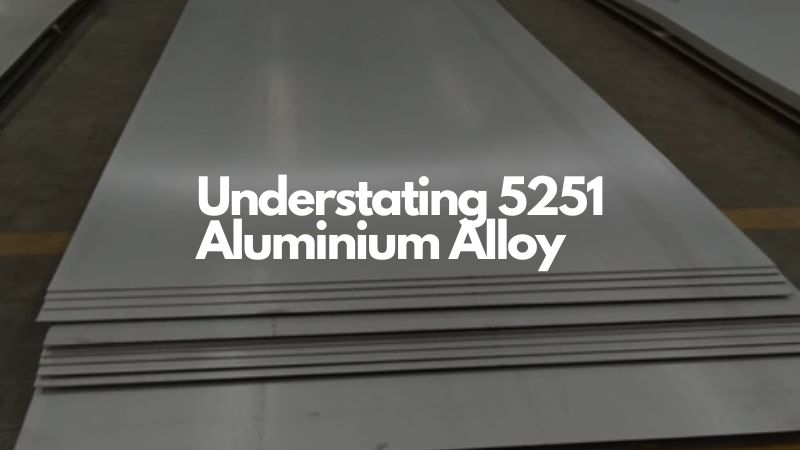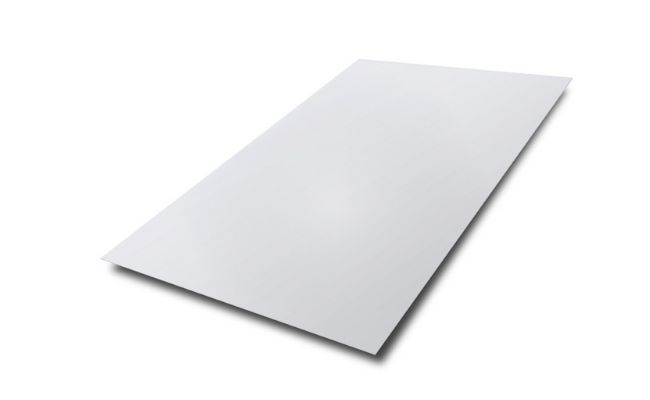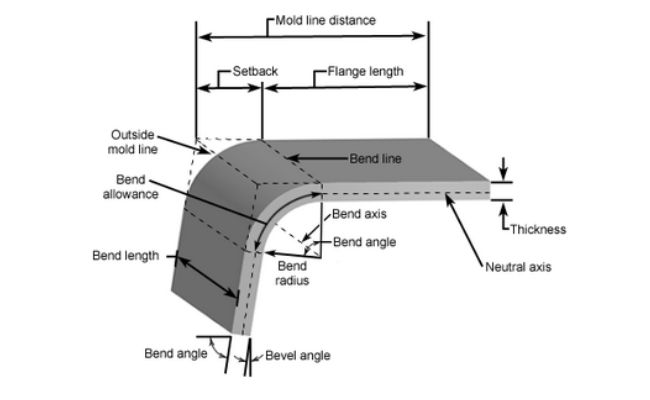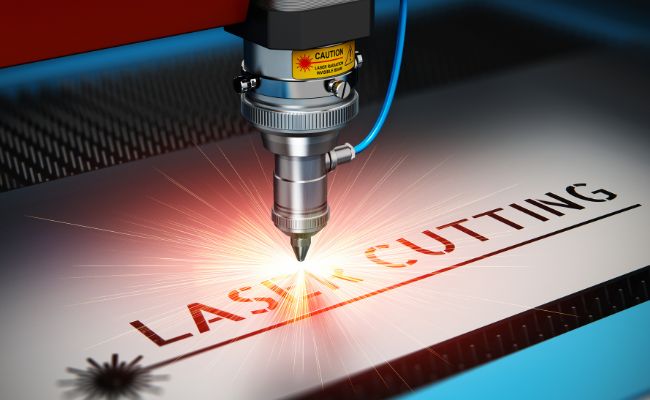
If you are choosing 5252 aluminum alloy, you should know the properties, fabrication capabilities and applications.
This guide explores everything about Alu 5251 alloy:
What is Aluminum Grade 5251?

Figure 1 Alu 5251 Sheet
Alu 5251 is a special grade popular for moderate hardness, and superior mechanical properties, with excellent formability.
The 5251 grade of aluminum welds well and work hardens quickly.
Benefits of 5251 Aluminum Alloy
These aluminum alloys are known for:
Ductility
The alloy grade can easily be drawn and deformed without fracture. Besides, it can be simple to handle with when cold in a hardened state.
Excellent Corrosion Resistance
Aluminum alloy 5251 naturally produces a thin yet strong oxide layer that resists subsequent oxidation, giving it remarkable corrosion resistance. The aluminum oxide is impenetrable.
Grade 5251 can be anodized by adding more thickness to the protective layer film to increase corrosion resistance.
Good Formability
You can bend 5251 Alu grade easily without interfering with its mechanical properties. This is due to its reasonable cold formability.
This Alu grade can be deformed during forming without generating unwanted shapes, folds, or flaws.
Ease of Weldability
5251 aluminum alloy is readily weldable. You can join it with other similar materials.
Additionally, the 5251 Alu alloy is known for:
- It is made of solid aluminum material and offers excellent fatigue strength, medium static strength, and good workability.
- Lightweight and durable because of the aluminum material.
- It may be processed with precision.
- Enhanced machinability characteristics
Aluminum Alloy Grade 5251 Properties
The Aluminium alloy has chemical, physical, and mechanical properties, making it suitable for various applications.
Chemical Composition
The chemical composition varies in percentage depending on the constituents.
Usually, the following are the elements of the 5251 grade aluminum alloy;

Figure 2 Alu 5251 Chemical composition
- Manganese – it constitutes a range of 0.10 to 0.50 percent.
- Magnesium – nominally contains between 1.7 and 2.4 percent.
- Copper – copper constitutes up to a maximum of 0.15 percent.
- Zinc – zinc makes up a maximum of 0.15 percent.
- Chromium – it is made of up to 0.15 maximum Chromium.
- Titanium – titanium makes up a maximum of 0.15 percent.
- Silicon – it constitutes a range of up to a maximum of 0.40 percent.
- Zinc – 0.15 percent maximum of Zinc.
- Iron – iron constitutes up to 0.50 percent maximum.
- Aluminium – The percentage chemical composition of Aluminium is usually balanced.
Physical Properties
The following are the physical properties of the 5251 aluminum alloy as explained;
- Density – density of 5251 aluminum alloy is 2.69g/cm3 comprising water and air.
- Thermal expansion – It is a moderately strong aluminum alloy that cannot be heated. Also, the thermal expansion of the alloy is 25 x 10-6/K
- Melting point – the melting point of aluminum alloy 5251 grade is 6250C. The temperature will rise when heat is added until 6250C is reached.
- Thermal conductivity – it has good thermal conductivity (134 W/m.K); hence heat is quickly transferred.
- Electricity resistivity – electrical resistance is 0.44 x 10-6 Ω.m.
- Modulus of elasticity – usually, the modulus of elasticity of this particular aluminum alloy is valued at 70 GPa.
The equivalent of aluminum 5251 grade is aluminum alloy NS4. Aluminum alloy NS4 H3 temper is relatively equivalent to Alu 5251 H22 temper.
Mechanical Properties
The following are the mechanical properties of aluminum 5251-grade alloy at room temperature;
- Tensile strength – its tensile strength is valued at 210 MPa.
- Proof stress – valued at 165 MPa.
- Shear strength – the shear strength of the 5251 grade is valued at 125 MPa.
- Hardness Vickers – the hardness Vickers of the alloy is valued at 65 HV.
- Elongation – at 14% is the standard length that aluminum 5251 grad stretched.
Fabricating Aluminum Grade 5251 Alloy Metal
To create the desired component, part, or completed parts during fabrication, a section of aluminum 5251 alloy metal is manipulated.
The procedure can involve Alu alloy material removal or material deformation. Here are some methods used in fabrication;
Bending/Folding Aluminium Grade 5251 Alloy
Bending is a process that involves aluminum alloy 5251 metal bending to fit the required specifications.
Additionally, aluminum Grade 5251 has good cold working properties. Although it is a fully flexible grade of aluminum, it is harder to bend since it has greater strength.

Figure 3 Sheet Metal Bending Parameters
Welding Alu 5251 Alloy
Metal alloys are melted together during welding processes.
Aluminium 5251 alloy is readily weldable.
The following are the standard methods used in the 5251-grade aluminum alloy welding process:
- TIG welding – TIG is suitable for alloy metal thickness ranges between 8-10mm. TIG uses an infusible tungsten-based electrode and electric arc to generate welds.
- MIG welding – This type of welding involves a wire electrode repeatedly fed through the welding gun and then into the weld pool. Shielding gas is fed through the gun to protect the pool from contamination.
Forming Alu 5251 Alloy
Through forming, aluminum alloy 5251 metal is reshaped without removing material. Metal can be shaped by stamping, bending, stretching, extruding, or roll-forming it into different shapes.
Forming distorts or bends the material to produce components and parts.
You can use brake bending machines or series of rollers. The workpiece is shaped into the desired form by repeatedly feeding aluminum alloy 5251 metal through the bending machine.
Cutting Alu 5251 Alloy

Figure 4 Laser Cutting Aluminum
Cutting involves the removal of material from the 5251 grade aluminum alloy metal.
Cuts can be shear or non-shear based on the fabricating design.
Shear cutting is more commonly utilized in non-industrial settings and is less accurate. Punching, also known as blanking, is another form of shear cutting in which a machine cuts out designs from a metal alloy, leaving the scrap.
Non-shear cutting is a precise method used in commercial settings.
A focused beam of light is used in laser cutting. Alternatively, heated compressed gases are used in plasma cutting.
Apart from these cutting options concentrated streams of water and abrasives are used in waterjet cutting.
When it comes to cutting holes, drill bits and lathe blades are used in machining to execute cutting without shear.
Metal Finish on Aluminum 5251 Grade
Following fabrication, the alloy metal goes through several finishing procedures that will improve its quality even more.
Finishing operations for manufactured parts, components, or finished goods of the 5251 Alu grade may include sandblasting, deburring, annealing, anodizing, painting or coating.
Aluminum Alloy 5251 Alloy Temper Options
Tamper options include:
- H24; rolling hardens the work, which is subsequently cured to a half-hard state.
- H26; it is three-quarters hard. Also, rolling the work hardened it.
- H22; rolling and annealing the work toughened it to a quarter-hard state.
- 0; it is soft.
It completely annealed after first being wrought.
Maintaining 5251 Aluminum Alloy
The best way to maintain aluminum’s beauty is through routine cleaning to eliminate dirt buildup.
If left for an extended amount of time, dirt can produce stains and depending on the degree of color, a more substantial cleaning procedure is needed to eliminate the color.
Always begin with the mildest cleaning method for aluminum, and only switch to progressively stronger treatments if necessary.
The following are the methods used in cleaning the 5251 aluminum alloy;
- Simple soap or detergent and water
- Kerosene, turpentine, or white spirit as solvents.
- Chemical cleaner without etching
- Polish made of wax
- Abrasive cleaner
- Abrasive wax
To avoid staining, the 5251 aluminum alloy is adequately rinsed and dried after cleaning.
Edges and connections should are given extra attention to remove all cleaning residue.
Always follow the manufacturer’s advice when using specialized cleaning products is recommended.
Aluminum 5251 Alloy Forms
There are various variants of the aluminum alloy 5251, including:
Sheet
Aluminum 5251 sheets are flat, thin slabs of aluminum that are wider and longer than their thickness, often less than 0.25 inches (6.35 mm).
These sheets are frequently utilized in applications that call for a lighter, corrosion-resistant, formable material.
Bars
With a rectangular or square cross-section, aluminum bars are solid, lengthy pieces of aluminum that are often thicker than strips.
These bars are frequently employed in applications that require high strength and excellent machinability.
Plates
Aluminum 5251 plates are flattened, rectangular slabs of metal that are wider and longer than thick. They are often thicker than aluminum sheets.
These plates are frequently employed in applications that require high strength, excellent formability, and corrosion resistance.
Strip
Aluminum 5251 strips are thin, flat pieces of metal with a width greater than their thickness, often less than 0.25 inches (6.35 mm).
These strips are frequently utilized in applications that call for a light, corrosion-resistant, formable material.
Tube
It is a hollowed cylindrical metal mostly used in hydraulic systems, and heat exchangers are two applications that use 5251 aluminum alloy tubes. The most common configurations are the round tubes.
Coil
Aluminium 5251 coil is a piece of metal coiled into a spiraling or helix shape. There are several uses for 5251 aluminum alloy coils, such as roofing and cladding.
Applications of 5251 Aluminum Alloy
- Boats – They are mainly used in repairing boats because it is highly resistant to corrosion.
- They are used in making boilers and pressure vessels.
- Architectural – You can use the meal to make architectural fascias and paneling.
- Aircraft – It is used to make some aircraft parts for their excellent fatigue strength.
- Transport industry and infrastructure
- Construction
- Storage facilities such as silos
- Used in making kitchen fittings and kitchen appliances.
Conclusion
As a result of its medium strength, 5251 aluminum grade ranks among the essential aluminum alloys.
Its good physical and mechanical properties make it more competitive, especially for marine and aircraft applications. Additionally, it has average alloy composition same as 5052 aluminum alloy.
More Resources:
Bending Aluminum – Source: KDM
Aluminum Welding – Source: KDM
Aluminum 5251 – Source: Azo Material
Aluminum Alloys – Source: Science Direct




